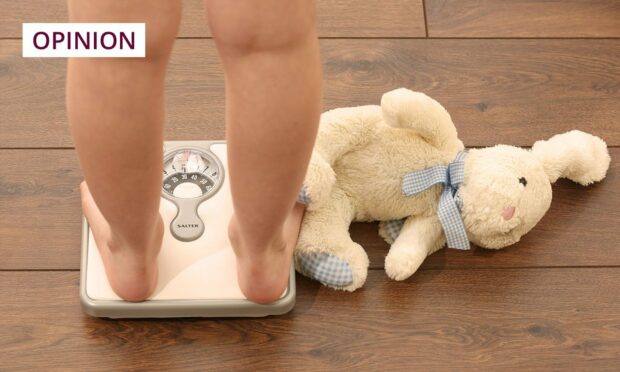“I don’t want to wear that jumper, mummy!”
“Why not?” I ask my daughter, surprised, for this isn’t one of our usual battlegrounds.
“It makes me look really fat …”
I wince, stunned by my five-year-old’s reply. Yes, she’s only five. For once, I’m momentarily speechless, caught completely off-guard.
This isn’t a topic we’ve discussed at home, other than to explain – while reading Roald Dahl’s Charlie and the Chocolate Factory – that fat, like stupid or ugly, isn’t a kind word to use. So why would she think that? Where is this coming from? And what does it mean?
Pulling myself together, I swiftly rattle off a few potentially reassuring compliments about how much the jumper suits her, how cosy it is and, thankfully, we move on – for now anyway.
But it’s a brutal wake-up call and I can’t shake the sick feeling in the pit of my stomach.
Relentless quest over healthy eating habits for children
Of course, I knew I’d be having these conversations with both my children at some point. We all have questions and doubts as we grow up. I’m just shocked at how soon we’ve arrived here, barely halfway through the first year of primary school.
Maybe I shouldn’t be. Perhaps I was naive not to be prepared for this from the off.
After-all, with a smartphone always to hand, kids today – mine included – are routinely photographed and filmed. They know how to smile, how to pose and often ask to see – or worse – “check” a picture after it’s been taken. In such a world, how could Maya not be aware of her body and have opinions on how she looks, opinions that will surely only become more pronounced as she gets older and social media inevitably starts to play a greater role in her life.

On top of that, there’s my relentless quest to ensure our family eats and lives well, so limiting unhealthy snacks, serving lots of fruit and vegetables, and getting plenty of exercise. We walk everywhere we can, for instance, and Maya has to choose which day she has a pudding at school.
This might seem strict – it is – but the statistics show I’m right to be concerned.
Warning over childhood obesity
The World Obesity Federation warned this month that more than half the world’s population will be overweight or obese by 2035 if the current trends prevail, with rates rising faster among children.
And data collected from 33 countries between 2018 and 2020 for the World Health Organization’s European Childhood Obesity Surveillance Initiative revealed that 29% of children aged 7-9 years are living with overweight or obesity.
Clearly, in this context, we absolutely have a duty to encourage our young people to eat properly, to enjoy fresh produce, and I make no apologies for keeping a close eye on what my son and daughter eat.
The global economic impact of overweight & obesity will reach $4.32 trillion annually by 2035 if prevention & treatment measures do not improve. 🚨
➡️ Read our latest report, the World Obesity Atlas, here: https://t.co/pEawmSjwja #Atlas2023 #WorldObesityDay ⭕️ pic.twitter.com/1tjUm19vJZ
— World Obesity (@WorldObesity) March 22, 2023
I’m realising, however, and Maya’s comment brought this into sharp focus, that I do need to be vigilant about how loudly I bang my drum. Because, while these figures are frightening, so is the estimate by Beat, the UK’s eating disorder charity, that approximately 1.25 million people in the UK have one.
Moreover, the journal JAMA Pediatrics reported last month that 22% of children and adolescents, based on 32 studies from 16 countries, showed disordered eating behaviours.
And according to a Scottish Parliament briefing from last June, in Scotland, the number of children under 18 admitted to a mental health or general or acute speciality with an eating disorder increased by 86% between 2019 and 2021.
Terrifying number of children with eating disorders
These numbers are equally terrifying, if not more so. And it begs the question – could my efforts to raise healthy human beings actually be doing more harm than good?
It fills me with horror to acknowledge that my best intentions might have contributed to Maya’s devastating self-analysis, but yes, quite possibly.
This is obviously a difficult balance to strike and there’s no easy answer. At the very least, I think we all have a responsibility, both parents and wider society, to pay attention to the language we use, taking particular care to talk about exercise in relation to a healthy lifestyle rather than linking it to weight loss and portraying skinny as the ideal.
We must also banish the notion that certain foods are naughty – as we suggest when we offer “treats” – and instead teach our little ones about the importance of moderation, a worthy lesson more generally too in our excess-filled and fuelled civilisation.
But above all we must – leading by example – help the next generation to feel comfortable in their own skins, instilling in youngsters the confidence to embrace who they are, regardless of size or shape.
For me, this has been a life-long journey, indeed, one I’m still on.
Hopefully, Maya and her peers will get there a little quicker.
Lindsay Razaq is a journalist and former P&J Westminster political correspondent who now combines freelance writing with being a first-time mum


Conversation